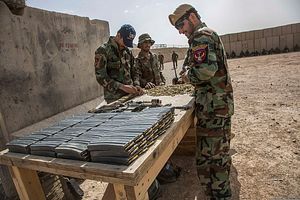What is going on in Afghanistan? After 15 years of U.S. and NATO involvement in the war torn country, many of Afghanistan’s cities find themselves surrounded and under siege by a resurgent Taliban force.
The train, advise, and assist mission known as Resolute Support, still contends that Afghan forces are capable of defending major cities and population centers. During a visit to the embattled city of Lashkar Gah, the commander of Resolute Support General Nicholson promised that the provincial capital of Helmand would never fall to the Taliban.
“The Afghan government and security forces are getting stronger each day and eventually they will be able to secure the entire province,” Nicholson said.
On October 11, 400 reinforcements for Afghan forces were spearheaded to the capital to prevent its collapse after a suicide bomber destroyed a police station and Taliban militants briefly entered the city.
In Farah city, Afghan forces continue to struggle against a Taliban onslaught as militants captured the city gateway and threatened to collapse the entire city, despite airstrikes carried out by Afghan forces on Monday that reportedly killed 27 Taliban militants.
Afghan forces are still struggling to push back an attack on Kunduz that occurred last Monday as Taliban forces launched coordinated attacks; and on Tuesday local reports indicate that Gormach district in Faryab province fell to militants as Afghan forces retreated from the area.
The poor performance of Afghan forces despite overtures from the Resolute Support mission that Afghan forces continue to “grow stronger each day” questions the reporting and metrics utilized by coalition forces to highlight strengths and current health of Afghan security forces.
An honest question that Resolute Support needs to ask itself is whether or not the Afghan army is on the verge of collapse and whether it is looking at the right indicators.
Anthony H. Cordesman, the Arleigh A. Burke Chair in Strategy at the Center for Strategic and International Studies, published a study in September titled “The Afghan War: Reshaping American Strategy and Finding Ways to Win.” In the study, Cordesman questioned the lack of meaningful DOD reporting on the threat in Afghanistan.
According to Cordesman, the one remaining metric being utilized by the DOD were “meaningless” charts on “Effective Enemy Initiated Attacks” that ignored rising civilian casualties in UN reports and Taliban territorial gains.
Cordesman argues that these charts assume that various insurgent groups in Afghanistan can only win by directly attacking Afghan security forces, rather than gaining influence by controlling rural areas of Afghanistan and thus forcing Afghan forces to retaliate–in effect changing the nature and behavior of security forces.
I indicated in a previous article for The National Interest that the United States and NATO should not be ignoring the rural sectors of Afghanistan. The U.S. strategy focused on population centers ignores historical realities of Afghan’s counterrevolutionary history, which has largely occurred in rural areas of the country. Still, General Nicholson argues that Afghan forces are winning because the Taliban only control 10 percent of the population, another pointless metric.
Cordesman contends that the United States must look beyond tactical measures. DOD reports include no measure of government effectiveness, socioeconomic conditions, corruption, or details on power broker relationships. Had these metrics been in place, the collapse of Kunduz would have been evident. Despite having a sizeable security force, Kunduz has been mismanaged and its forces have been subject to the whims of political power brokers intertwined in a complex patronage network.
The United States and its coalition partners need to reexamine how they analyze Afghan force success on the battlefield. It is simply not enough to look at size and equipment matchups with Taliban forces or tactical successes. Afghanistan is a complex entity with many actors and power brokers who all have an effect on the utility of Afghan forces.

































